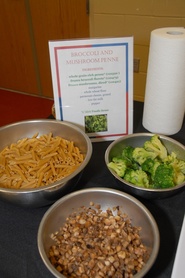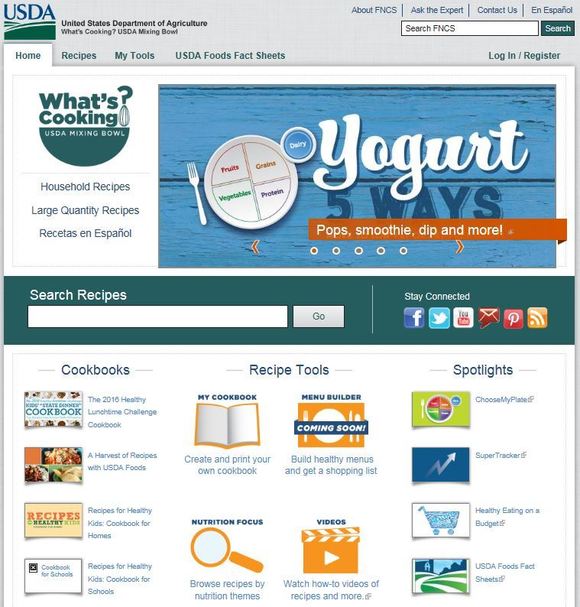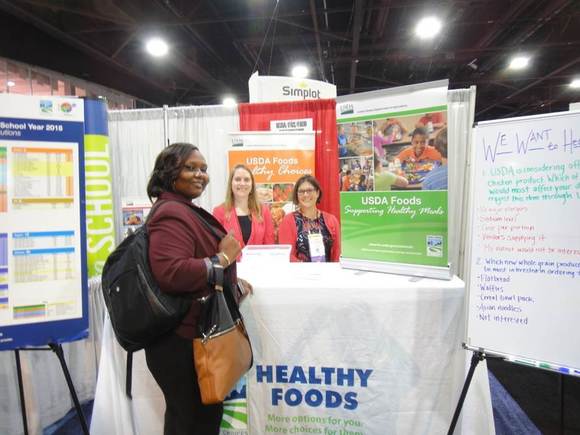|
On June 13, 2017, USDA staff visited
the St. Louis Area Foodbank in St. Louis, Missouri, while in town for the
National Association of Food Distribution Programs on Indian Reservations (NAFDPIR) annual conference. During the visit, USDA and food bank staff discussed
State-level and agency operations for the Commodity Supplemental Food Program
(CSFP) and The Emergency Food Assistance Program (TEFAP). Discussions
included conversations in the area of food storage and distribution -- for example, sharing
full trucks of TEFAP and CSFP foods with other States in instances when a full
truck cannot be utilized, and agency-level TEFAP food ordering in the Web-Based
Supply Chain Management system (WBSCM) -- and the use of USDA Foods in food bank
programs such as school pantries. Food bank staff provided a tour of the facility, and USDA staff were able to see volunteers packing CSFP boxes. Pictured above are USDA staff and food bank staff.
Read more about the St. Louis Area
Foodbank and its programs here!
 Pasta may be a staple item for many schools and families, but whole grain pasta is a unique type of pasta that may not be as familiar. Whole grain pasta is gaining popularity because it adds fiber, vitamins, and minerals to the meal and research continues to show the value of whole grains to overall health and prevention of diseases.
Did you know that whole grain pasta takes longer to cook than enriched pasta? It’s important to treat whole grain pasta as its own product, not as a direct substitute for enriched pasta, since whole grain cooking times and instructions can vary. For households, be sure to check the cooking instructions on the outside of the box. For schools, check out this fantastic pasta cooking resource developed by the Texas Department of Agriculture.
|
 |
|
Be sure to check out What’s Cooking for whole grain recipe ideas, such as the Chic Pasta and Whole Grain Rotini Pasta Salad.
Pictured to the left is Broccoli and Mushroom Penne, using USDA Foods whole grain-rich penne, frozen broccoli florets, and frozen diced mushrooms (ingredients for this recipe pictured in the photo above at a "Behind the Scenes with USDA Foods" tasting event).
|
 BMI Update: Checkloading Pilot
As part of the USDA Foods Business Management Improvement project, USDA has begun a pilot to help better align USDA purchase specifications with existing commercial practices. This pilot eliminates the requirement for checkloading by USDA inspectors for certain canned fruit products. Checkloading by a USDA inspector refers to the verification that product had been previously inspected by a USDA inspector and found to meet contract requirements. It also includes examination of the product for condition of containers, compliance with labeling and container marking requirements, and determination of the number of containers at the time of loading into the truck or shipping container. USDA has received feedback from vendors that checkloading is a process routinely performed by vendors and that the requirement for a USDA inspector to perform the checkloading examination was an additional expense and often delayed shipment of product due to inspector availability. USDA Foods complaint data will be used to evaluate the effectiveness of this pilot.
|
The national average value of USDA Foods assistance or “commodity per meal rate” is published each year in the
Federal Register. The per meal rate notice announcing the new School Year (SY) 2018 rate was published in
the Federal Register on July 28, 2017, and
can be found here.
The per
meal rate for National
School Lunch Program (NSLP) and Child
and Adult Care Food Program (CACFP) for SY18 is 23.25 cents, which is an
increase from 23 cents in SY17. The rate
is based on the published Bureau of Labor Statistics’ Producer Price Index data
and is adjusted each year.
For
NSLP, USDA then adds up the USDA Foods purchases to ensure they are at least 12
percent of the total federal assistance provided in the NSLP. If they are not,
then the dollar difference is added to increase the per meal rate and it is
then called the “effective” per meal rate and distributed to States in WBSCM.
For NSLP the per meal rate plus the 12% dollars make the effective SY18 rate 33.50
cents.
Check out What’s Cooking! USDA maintains the What’s
Cooking site filled with recipes for both households and quantity
foodservice. You can search for recipes
using particular food items to get ideas for new, creative ways to use your
USDA Foods or browse cookbooks targeted to specific audiences. With nutrition information available for each
recipe, this site is packed with useful information for schools and families!

School Nutrition
Association (SNA) Annual National Conference 2017
In July, staff from the Food Distribution Division (FDD) had
a chance to interact with many stakeholders from State agencies, school
districts, and industry groups at the SNA Conference in Atlanta, Georgia. During the conference, FDD staff hosted a
booth with information about USDA Foods for Schools. Staff asked school
districts to answer two questions each day to help inform the future direction
of USDA Foods. We appreciate the great
feedback received and plan to take this information into consideration as we
move forward with developing the Foods Available List for SY19 and SY20. If you have any thoughts about new products
you would like to see through USDA Foods, you can always email us at USDAFoods@fns.usda.gov. Staff also had
an opportunity to speak to conference attendees during the session “The Latest
Dish on USDA Foods” which covered new school products, tasting events, changes
in the USDA DoD Fresh Program, and information about the Business Management
Improvement Process currently underway at USDA. We are always excited for an opportunity to talk to stakeholders and this
conference provided a wealth of feedback to incorporate into our future USDA
Foods efforts.
 |
FDD staff Shenique Bridges, Christina Riley, and Julie Skolmowski at the USDA Foods booth at SNA's conference
 Thank you to everyone who participated in our "USDA Foods from Farm to Plate" e-letter survey in April and May! We appreciate your letting us know what type of content you most enjoy reading and will incorporate your feedback as we develop future editions. You are welcome to send suggestions and ideas any time to USDAFoods@fns.usda.gov. Thanks for being a subscriber!
|
USDA Foods Feedback
To help ensure that USDA Foods meet customer expectations, it is
important to us that the people using USDA Foods provide us with feedback. We need to hear from you on what you like,
what doesn’t meet your expectations, and most importantly if there is an issue
with a USDA Food. Your feedback helps us
to improve USDA Foods specifications and provide products that meet your
expectations. Recipient Agencies
(RA) who have issues/concerns with USDA Foods product(s) should
contact their State Distributing Agency (SDA) with as much information as
possible. The SDA will report the complaint
through the Web-Based Supply Chain Management system (WBSCM). In order
to expedite the complaint process, the following information is needed
to enter a complaint in WBSCM:
- Sales
Order and Sales Order Line Item numbers
- Purchase
Order and Purchase Order Line Item number
- Lot
code (found on outside of cases or on cans)
- Date
of delivery
- Date
of incident
- Detailed description of issue
- Quantity
of product affected (number of cases)
- Quantity
of product remaining (number of cases)
- Physical
address of remaining product
- Contact
name
- Contact
organization
- Contact
telephone
- Contact
email
-
Photos
(include photos that clearly show what the problem is). Photos of
cases, cans, product, and product labels are very helpful to the Complaint
Team and the vendor(s).
Providing all of the requested information when submitting a
complaint helps us to provide a timely response. Missing information can delay the
resolution process.
For more information,
review How to File a USDA Foods Complaint.
USDA Foods Complaint Hotline: 800-446-6991
Email: USDAFoodsComplaints@fns.usda.gov
The Complaint Team is available Monday-Friday, 6:00 a.m. – 5:00
p.m. Eastern Time.
USDA DoD Fresh Fruit and Vegetable Program Complaint Process
Another USDA Foods option is the USDA DoD Fresh Program. Recipient Agencies are to report issues with produce received through the USDA DoD Fresh to the appropriate DoD Service Representative, the vendor, and the State Distributing Agency. Indian Tribal Organizations are to report issues with produce received through the USDA DoD Fresh to their designated DoD service representative, the vendor and the appropriate FNS Regional Office. It is recommended to inspect produce at the time of delivery and document on the delivery document any quality or condition issues, or product shortages. It is important that all issues regarding quality, condition, availability, and delivery are documented on the delivery document and include specific details of the issue(s). Please make copies of this documentation and maintain for your records.
If issues are reported and not resolved, please contact the USDA Complaints Team. The Complaint Team will work with DoD to resolve the issue. We welcome your feedback on USDA Foods products.
New User Requests
New users
who will be accessing Fresh
Fruits and Vegetables Order/Receipt System (FFAVORS) and/or Web-Based Supply Chain Management system
(WBSCM) should have their own profile(s) and login credentials. Both of
these applications use eAuthentication
to manage login credentials; however, creating an eAuthentication account will
not automatically grant access to these applications.
New users
should request access as follows:
-
FFAVORS: Contact your current Department of Defense (DoD)
Account Manager, Field Representative, and/or Contracting
Specialist to request access. If you do not know your DoD contact(s) or have trouble accessing
FFAVORS with your new login ID and password, the FFAVORS Help Desk can assist you. Additional tips can be found in the FFAVORS f.a.q.
-
WBSCM: Contact the User Administrator for your
organization (SDA, RA, ITO, etc.) to request access. Additional tips can be
found in the WBSCM f.a.q.
Note: User
Administrators can find guidance on creating a new user profile in WBSCM under Help -> Training (tab) -> Work
Instructions -> External -> Fulfillment -> Domestic -> Create User.
After the
profile has been created in FFAVORS or WBSCM, the new user will receive an
email with instructions to create, activate,
and register their eAuthentication account. New users should be careful when
setting up their eAuthentication account; most errors encountered during
registration result from selecting the wrong link in the email message or not
entering the Last Name and Email exactly the same way as in FFAVORS/WBSCM.
Recovering Login Information
The service
desk teams for WBSCM and FFAVORS cannot recover user login credentials. These
are maintained in a separate system called eAuthentication. To
recover forgotten information, self-service tools are available from the login
screen via the I forgot my User ID |
Password links.
To
recover forgotten User ID(s), click on User
ID. After entering your information, you will receive a list of any User
ID(s) linked to this email.
To reset
your Password, click on Password.
You will be prompted to enter your User ID and answer the security questions
you previously set up for your eAuthentication profile. After confirming your
identity, you will be prompted to enter a new password. This action will also
unlock your account if you had entered the wrong password too many times. Note: The Change
my Password link can be used to update your account only if you know your
current password.
For your
convenience, a shortcut to the password reset tool is also provided on the webpages
for WBSCM
and FFAVORS:
If you have
forgotten both your password and your security question responses:
-
Users with a LincPass
(USDA-issued ID) should contact
the eAuthentication Service Desk for assistance at 1-800-457-3642, option 1.
-
Users without a LincPass will need to reestablish access
to FFAVORS and/or WBSCM with a new login ID. To update FFAVORS, contact the FFAVORS Help Desk. For WBSCM, contact the
user administrator for your organization.
WBSCM Help Document Library
New and experienced users alike can find several useful resources that provide instructions, guidance, and general information to help them work proficiently with WBSCM. These materials are regularly updated to correspond to the current best practices, application enhancements, and system requirements to provide convenient solutions to common questions.
Work Instructions: Step-by-step instructions and screenshots are available for common transactions. These can be located by browsing by role and business function or using a keyword search. Work instructions may be viewed as detailed steps with screenshots (Work Instruction), basic steps (Quick Reference), or as an interactive on-screen demo (Simulation). Within WBSCM, navigate to Help -> Training -> Work Instructions.
Job Aids: These resources provide guidance for reports, general navigation and user preference tips, and miscellaneous references. Job aids are grouped by category: General Help, Finance, Fulfillment, Procurement, and Reports. Within WBSCM, navigate to Help -> Training -> Job Aids.
Release Notes: WBSCM is under continuous development to address known issues and/or introduce new or enhanced features. A description of the changes, the roles impacted, and links to related instructions are published with each release. Within WBSCM, navigate to Help -> Training -> Release Notes.
For additional assistance contact the WBSCM Service Desk or call (877) 927-2648.
USDA staff will be participating in these upcoming meetings in 2017. We look forward to the opportunity to meet you and hope to see you there!
September 18-20: Second Annual Conference on Native American Nutrition in Prior Lake, Minnesota, hosted by Seeds of Native Health.
October 24-25: Agricultural Marketing Service (AMS) 2017 Annual Industry Meeting for USDA Foods Contractors and Suppliers in Arlington, Virginia.
 Here's how to sign up for these updates via GovDelivery:
1. Go to the Food Distribution website.
2. Click on the red envelope on the row of social media icons on the top right of the page.
3. Enter your email address and click "Submit."
4. Check the boxes to select your topics of interest. For these e-letters, scroll down to the Food Distribution category and click the plus sign to the left of the check box to expand the list and view all the sub-categories. Check these sub-categories to receive the corresponding e-letters:
*USDA Foods --> receive all "USDA Foods from Farm to Plate" general + program-specific e-letters
*Commodity Supplemental Food Program (CSFP) --> receive "Household Highlights" e-letter
*The Emergency Food Assistance Program (TEFAP) --> receive "Household Highlights" e-letter
*Food Distribution Program on Indian Reservations (FDPIR) --> receive "FDPIR Connection" e-letter
*Schools/Child Nutrition Commodity Programs --> receive "Spotlight on Schools" e-letter
5. Update your subscription preferences any time by following the above steps or clicking on the Subscriber Preferences Page link at the bottom of any of the e-letter email messages you receive from GovDelivery. Questions? Contact us at USDAFoods@fns.usda.gov
|
|